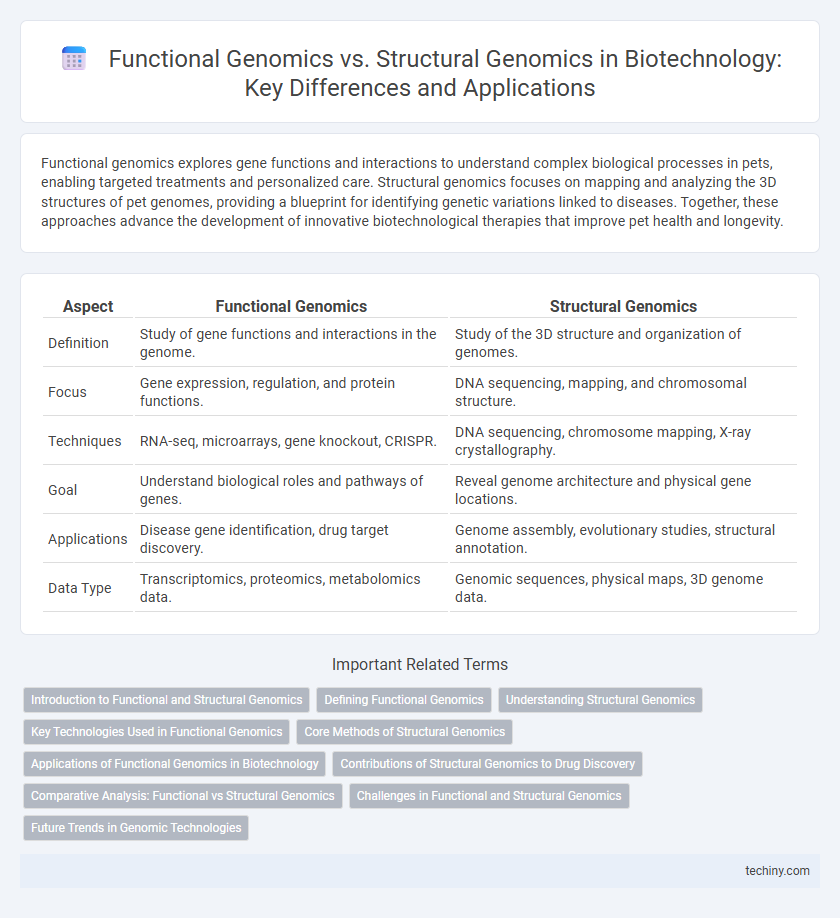Functional genomics explores gene functions and interactions to understand complex biological processes in pets, enabling targeted treatments and personalized care. Structural genomics focuses on mapping and analyzing the 3D structures of pet genomes, providing a blueprint for identifying genetic variations linked to diseases. Together, these approaches advance the development of innovative biotechnological therapies that improve pet health and longevity.
Table of Comparison
| Aspect | Functional Genomics | Structural Genomics |
|---|---|---|
| Definition | Study of gene functions and interactions in the genome. | Study of the 3D structure and organization of genomes. |
| Focus | Gene expression, regulation, and protein functions. | DNA sequencing, mapping, and chromosomal structure. |
| Techniques | RNA-seq, microarrays, gene knockout, CRISPR. | DNA sequencing, chromosome mapping, X-ray crystallography. |
| Goal | Understand biological roles and pathways of genes. | Reveal genome architecture and physical gene locations. |
| Applications | Disease gene identification, drug target discovery. | Genome assembly, evolutionary studies, structural annotation. |
| Data Type | Transcriptomics, proteomics, metabolomics data. | Genomic sequences, physical maps, 3D genome data. |
Introduction to Functional and Structural Genomics
Functional genomics explores gene functions and interactions by analyzing RNA, proteins, and metabolites to understand biological processes and phenotypes. Structural genomics aims to determine the three-dimensional structures of all proteins encoded by a genome, providing insights into molecular mechanisms and aiding drug design. Together, these disciplines complement each other by linking gene structure to function, advancing comprehensive genomic research.
Defining Functional Genomics
Functional genomics explores the dynamic aspects of gene expression and protein interactions to understand gene functions within biological systems. It employs high-throughput techniques like RNA sequencing and CRISPR screens to analyze genome-wide gene activity and regulatory networks. Unlike structural genomics, which maps the physical DNA sequence, functional genomics emphasizes the relationship between genotype and phenotype by investigating gene roles in cellular processes.
Understanding Structural Genomics
Structural genomics focuses on determining the three-dimensional structures of entire sets of proteins encoded by genomes, facilitating insights into protein function and interaction. This approach utilizes high-throughput techniques such as X-ray crystallography, NMR spectroscopy, and cryo-electron microscopy to generate comprehensive protein structure databases. Understanding protein structures at this scale advances drug design, molecular biology, and the annotation of genome sequences in biotechnology.
Key Technologies Used in Functional Genomics
Functional genomics employs key technologies such as RNA sequencing (RNA-seq), microarrays, and CRISPR-Cas9 gene editing to investigate gene expression, regulation, and interaction on a genome-wide scale. Techniques like chromatin immunoprecipitation sequencing (ChIP-seq) and proteomics further enable detailed analysis of protein-DNA interactions and functional protein networks. These technologies collectively enhance understanding of dynamic biological processes beyond the static DNA sequences analyzed in structural genomics.
Core Methods of Structural Genomics
Structural genomics primarily employs high-throughput techniques such as X-ray crystallography, nuclear magnetic resonance (NMR) spectroscopy, and cryo-electron microscopy (cryo-EM) to determine the three-dimensional structures of proteins and nucleic acids. These methods enable the systematic analysis of protein folds and domain architectures, contributing to the comprehensive mapping of organismal protein structures. Functional genomics, in contrast, focuses on genome-wide gene expression and gene function analysis, utilizing technologies like RNA sequencing and functional assays rather than detailed structural characterization.
Applications of Functional Genomics in Biotechnology
Functional genomics in biotechnology enables the identification of gene functions and their interactions, facilitating the development of genetically modified organisms with enhanced traits such as increased yield and disease resistance. Techniques like RNA interference and CRISPR-Cas9 are applied to analyze gene expression patterns and regulatory networks, accelerating drug discovery and personalized medicine. Functional genomics also supports metabolic pathway engineering, optimizing microbial production of biofuels, pharmaceuticals, and industrial enzymes.
Contributions of Structural Genomics to Drug Discovery
Structural genomics provides comprehensive three-dimensional protein structures, enabling precise identification of drug binding sites and facilitating rational drug design. High-throughput structure determination accelerates target validation and the discovery of lead compounds by revealing molecular conformations critical for biological function. Integration of structural data with biochemical assays enhances optimization of drug candidates, improving efficacy and reducing off-target effects.
Comparative Analysis: Functional vs Structural Genomics
Functional genomics investigates gene expression and phenotypic impact by analyzing transcriptomes, proteomes, and metabolomes, providing insights into gene activity and biological pathways. Structural genomics focuses on determining three-dimensional protein structures and mapping genomic sequences to understand gene organization and genome architecture. Comparative analysis reveals that functional genomics emphasizes dynamic biological functions and regulatory mechanisms, while structural genomics prioritizes static gene configurations and molecular frameworks, making both essential for comprehensive genomic studies.
Challenges in Functional and Structural Genomics
Functional genomics faces challenges such as the complexity of gene expression regulation and the difficulty in assigning precise functions to genes within diverse biological contexts. Structural genomics contends with obstacles in determining high-resolution, three-dimensional protein structures, often limited by protein crystallization and conformational flexibility. Both fields require advanced computational tools and integrative approaches to overcome experimental limitations and enhance biological understanding.
Future Trends in Genomic Technologies
Future trends in genomic technologies emphasize integrating functional genomics with structural genomics to enhance the understanding of gene regulation and interaction networks. Advances in high-throughput sequencing, single-cell analysis, and CRISPR-based functional screens are expected to drive precise gene editing and dynamic mapping of genome function. Emerging AI-driven analytics and multi-omics integration promise to accelerate discovery in personalized medicine and synthetic biology by linking genetic structures with biological function.
Functional genomics vs Structural genomics Infographic

 techiny.com
techiny.com